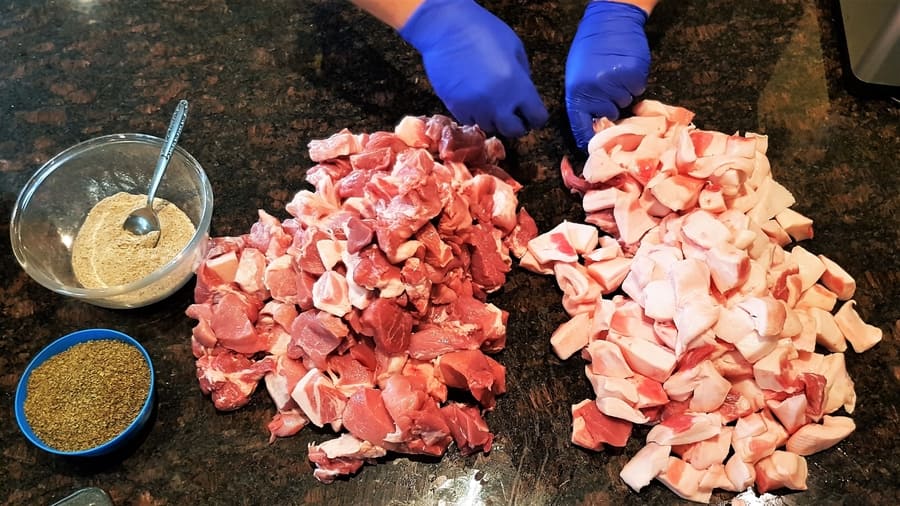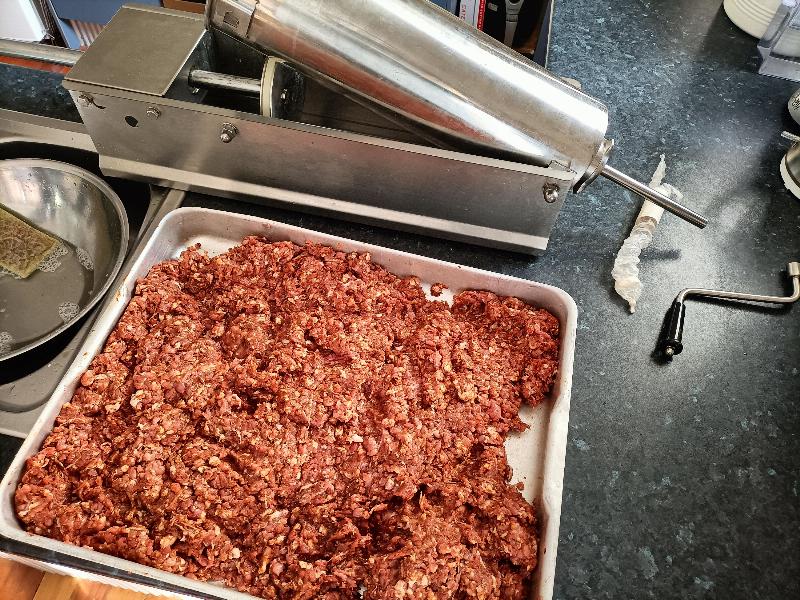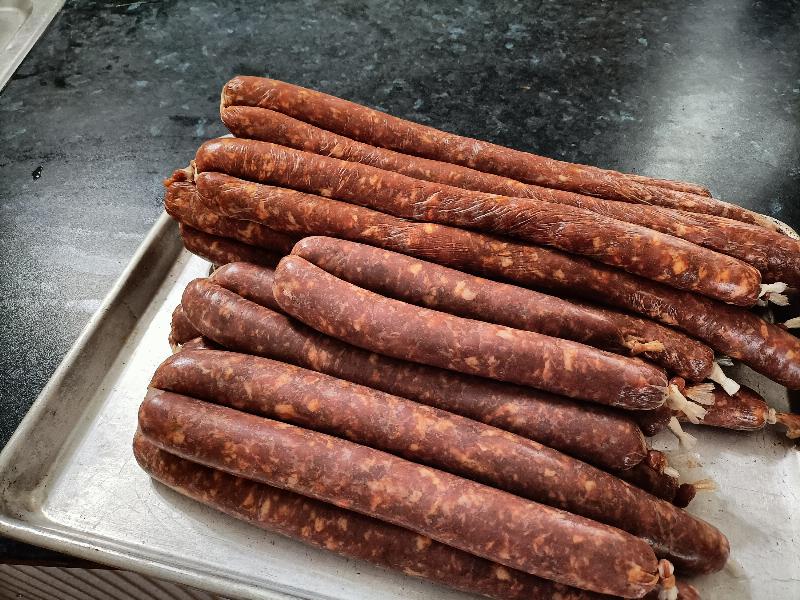Cuts of meat vary greatly when making sausages or salami. Farmed or wild meat has some key differences, as do the various prime and sub-prime cuts available.
I’ve enjoyed making sausage for decades and have become proficient at various dry-cured and hot-smoked salamis.
It’s a massive topic, and I’ve learned from many resources since the online content is still lacking. That’s another reason why I started this blog, www.eatcuredmeat.com.
There is one golden rule for nearly any sausage or salami: You need a 20+% fat-to-meat ratio. Some cuts carry more intermuscular fat than others, too. This means the meat is embedded with fat rather than being white, and the meat is separated like pork belly.
I’ve learned this the hard way when I use wild meat like venison for sausage or dry-cured salami: I don’t use enough fat. For fresh sausages (see article on cooked sausages of the world), it’s very important; for dry-cured salami, not so much since you are salting, then drying, not cooking.

I will cover the main aspects of beef and pork you will use for most sausage-making.
But just remember, if you are going to use lean meat like elk, venison, tahr, reindeer, bear, wild duck, wild rabbit, etc., you will need that 20%+ fat. Ideally, neutral-tasting fat like pork should be back fat as well (hard fat, higher melting point in terms of temperature).
Another aspect is that I am talking about non-emulsified sausage generally – so that means no ice or added super cold water to get that smoother texture via myosin extraction of the meat. (This is when you get that generic smoother texture of meat; emulsifying is the same technique why mayonnaise is oil and egg, but it’s creamy and amalgamated)
ie, hot dogs or bologna
Another tip is to buy whole muscle with the bone in from a butcher. You will pay less per pound or kg. I love entire chunks because I can make healthy broths and stocks with the bones. This is real bone-ness!
You can not go wrong with pork as your primary meat since it has fat and lends itself well to sausages/salami. When you think about it, it’s what a sausage is, nearly defined as – pork included.
But I hunt and use various other types of meat; I’ve made and researched exotic styles like Asian sausages, which may include fish or lamb, for instance.
Best Cuts of Meat for Sausage Making
- Pork Butt /Pork Shoulder
- Pork Belly
- Beef Brisket / Chuck
| Pork | Beef /Veal |
| Pork Shoulder / Boston Butt | Beef Shoulder / Chuck |
| Pork Belly | Front Chest /Brisket |
When we are talking about Pork, the shoulder, which includes the butt, is often a little fattier. It does depend on the age of the pig, however, and what it’s been fed, etc.
You can mince/grind the entire hind leg of the pig if you have it, but it depends on what you want to achieve. This way, you would like to ensure that 20% fat ratio.
The sirloin, ham, and lots of the ‘roasting’ types of cuts are on the hind leg. But it’s your call!
I’m going to cover the most helpful aspect of sausage making for each meat type (check out some other tips here):
- Pork
- Beef/Veal
- Farmed Venison
- Poultry
- Wild Game
- Fish
We will discuss ‘prime’ cuts and ‘subprime’ cuts. To keep it simple, prime cuts are steaks that are fast to fry/grill or great for roasting.
Since bacteria form faster on ground or minced meat due to oxygen exposure, I would not advise buying minced meat—unless it was ground meat in front of my eyes.
Prime Cut not for Sausage Making
- Ribeye
- Porterhouse
- Loin
- Sirloin
- Round
Generally, these are fast-cooking cuts that should be tender. They could also be used for sausages, although they tend to be more suited to grilling and frying.
Pork Shoulder may contain a fair amount of fat, especially from a more mature animal (over 8 months of age).
There are variations, so I am giving general guidelines in this rundown.
Shoulder meat from venison, pork, or beef is cost-effective since it’s less-than-desirable. There is nothing wrong with the shoulder.
But often, when I harvest deer, the forequarter or shoulder requires the most work to extract the least amount of so-called ‘prime’ meat; deboning it takes time.
Cubing and mincing it takes time, but it’s a good lean cut to add to the mix—wild venison (in New Zealand).
Poultry
It might sound a bit crazy for some folks, but fresh chicken can be used for sausages, and pretty much any meat from the chicken that doesn’t have bone on it, i.e., deboned carefully. Chicken takes on bacteria fast, like fish, so processing this meat fast is key.
Fish
Of course, fillets and no bone for a fish sausage sounds crazy to a Westerner, but South East Asia has many exotic recipes for this type of sausage (lemongrass, ginger fish sausage – yum!).
Beef
Chuck, which is the shoulder of the bovine is cost-effective for sausage making, brisket was cost-effective. Since low and slow BBQ has become fashionable, prices in the Western world have gone way up.
Cooking programs have also changed the demand for pork belly. I used to be able to get it for free from the butcher, but now it’s almost three times or four times the price.
Any decent deal on whole-muscle meat is fine. Some older bovines may have tougher sinew connecting the muscles, so you may want to remove this for your sausage grinding.
Venison
There is farmed and wild venison. Anything farmed has a softer texture in terms of the meat, and especially the sinew that connects the different muscle groups.
After processing hundreds or more pounds of harvested meat, you noticed it.
With wild venison (here is an article about specifically venison cuts) or boar, I like to remove a lot of the tougher sinew. It will undoubtedly get stuck in the mincer/grinder. For farmed pork, I don’t have issues, and sinew is left on—unless it feels tough.
As a general rule, if I can pull off the sinew by hand, I can put it in my sausage meat grinder.
Fat for Sausage Making
I am lucky and have a place where I can order frozen pork back fat. If I feel the meat/fat ratio is too low, I can order a bag at a reasonable cost.
For instance, this is pork shoulder 90% and pork belly 10% for some Hungarian Dry-Cured, 18-hour Cold-Smoked Salami—maybe it would be approx. 15% fat, but with dry-cured salami. You can get away with a little less fat since it’s not cooking it, where the fat would keep the sausage moist. It has heaps of paprika, garlic, cumin, and black pepper.


Beef fat or tallow has a different flavor altogether.
Pork fat is very neutral, compared to pretty much any other fat. That is why it’s the main fat for sausages or salami. Even many recipes that are not pork-based are still often have pork fat for the ratio of meat to fat.
I know venison fat is relevant in different parts of the world, but often, guys don’t want to use it because it has a distinct, odd flavor for sausages.
Pork Cuts for Sausage Making
Pork Butt (Boston Butt) the shoulder is an economical cut of meat for sausage making
It generally has a 15-25% ratio, with separate and intermuscular fat (again, depending on the animal’s age/diet/exercise—these are generalizations).
I often get a cross-sectioned sliced shoulder roast from the butcher on special. Because it’s easier for them and more economical, it has bone and a little skin, so I remove this and cube it up.
I dry out the skin and make crackling, just add salt and cook at high heat.
When we have a whole bag of bones, we put them in our ‘broth/stock’ bag in the freezer—we make stock/broth! Superfood!
I prefer to break a half or whole pig, but around where I live – pig breeders kill the pigs pretty early, so I need to find a way for someone to age a pig for longer than a year to develop more fat (and a special diet I think, acorns from the local park! This is what Iberian Jamon Dry Cured Ham is finished on).
I would generally not use loins since they’re a great steak/prime cut. Rump, as well, is versatile, but it really depends on what I can get.
Old Animals Often Have More Fat
As mentioned above, especially for pork, you get a lot more fat. It’s also going to relate to how much movement the animal has been accustomed to.
Offal for Sausage Making
Pork or Beef Liver can be used if it is extremely fresh. The animal is butchered within a few days, and the liver is kept refrigerated.
I’ve got recipes for offal sausages, but haven’t yet pushed the button on making these!
Meat Needs to be Fresh
Bacteria growth in meat is exponential, this is why it’s so important to keep the meat chilled, slightly above freezing after it has been killed.
Also, when mincing or grinding meat for sausage or binding (releasing some of the myosins in the meat for tackiness), you want to operate at just above freezing level. It’s all about minimizing the bacteria.
Frozen Meat for Sausage Making
If the meat is frozen fresh, it can be used to make sausages or salami.
I will often cube up fresh meat and freeze it for salami later, remember though, if you are making fresh sausages (link to the sausage category on this site) from thawed frozen meat. Once you have made them, it’s not advisable to -refreeze the meat.
Never had issues, also using frozen whole chunks of meat for dry curing chunks like braesola or pancetta.
Whole Animal Butchery
“Good cuts of meat make good sausages. If you are brutally efficient, trim out all gristle, sinew, and excess fat & blood clots,”. save those trimmings for later.
Emulsified sausages (hot dogs, bologna), headcheeses, and liver sausages need the lower class of meat (tendons, gristles, skins, deboned meat) that is very rich in collagen. But you need a commercial heavy-duty grinder to mince this stuff properly.
My friends have these 1HP+ grinders, but I am currently reviewing a 1/2 HP, which is great for 10-20pound mincing runs.
You’re probably best to leave it out of your meaty sausages.
Fillers in Sausage Making
In some countries, the situation is so rampant that a hot dog contains only 15 % of meat and the rest are fillers, binders, and flavor enhancers. But it looks presentable, has an acceptable taste and most important is reasonably priced.
Meat & Sausages
Also, the British and other Western countries were fond of ‘bulking’ up the sausage with breadcrumbs or some other derivative, since meat has traditionally been a luxury type of good through the ages.
It’s not my style to use fillers, but I realize it originates from a lack of resources historically. Meat was a luxury too.
Best Meat Grinder for Sausage Making
I have seen many grinders available that are less than adequate. You have to have a certain level of grunt to get the job done.
If you don’t have the power, the grinding becomes pathetically slow. You also get much more ‘binding’ or ’emulsifying’—instead of the meat cutting, it’s squishing.
Here is a link to decent grinders that you should consider for sausage or salami making.

Tom Mueller
For decades, immersed in studying, working, learning, and teaching the craft of meat curing, sharing the passion and showcasing the world of charcuterie and smoked meat. Read More
